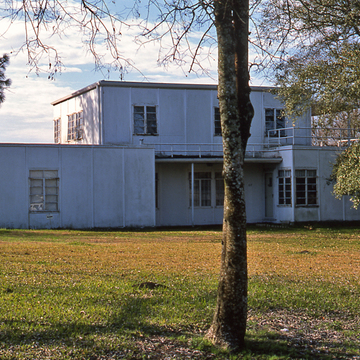Architectural historian Ben Koush has established the genealogy of this modernistic house, built for Dan J. Holland, an engineer at Humble's Baytown refinery, on a spectacular site overlooking Scott Bay. It is a “Motohome,” a system designed by New York City architect Robert W. McLaughlin in the early 1930s and marketed through American Homes, which licensed Houston contractors H. C. Christensen and L. H. Jolley to construct what seems to have been the only regional example. Built on a concrete-slab foundation, the house is framed with steel columns and joists, and finished internally and externally with cement panels laminated to an insulated core, bolted to the steel frame, and sealed with aluminum battens. Metal-edged composition planks provide both floor and roof surfaces.
Crow Street, which the house faces, lines up with the east elevation of the San Jacinto Monument ( AT24) across Galveston Bay. In the afternoon, the obelisk's slender shaft is ominously shadowed, as though memorializing the sad fate of the Brownwood subdivision, which began where Crow Street is now blockaded. Between 1961 and 1983 Brown-wood subsided into Galveston Bay, leading the city government to acquire all the frequently flooded house sites, demolish the houses, and convert the entire subdivision into an ecological park.

